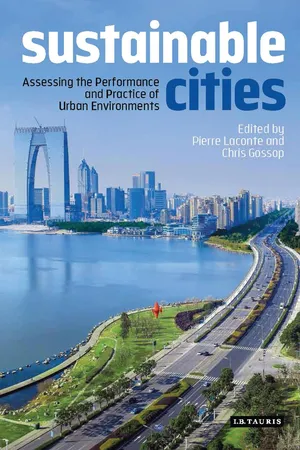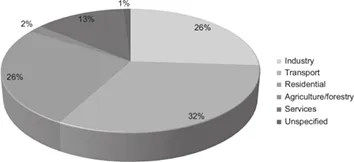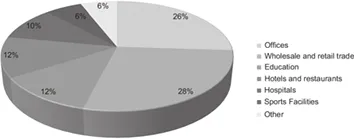![]()
PART I
LEVELS OF OBSERVATION
![]()
CHAPTER 1
ENERGY USE IN BUILDINGS: CONTRIBUTIONS AND CONSIDERATIONS IN URBAN SYSTEMS
Kerry J. Mashford
The achievement of truly sustainable urban environments depends on the sustainability of the individual elements that make up a town or city as well as how these elements work together to create effective and sustainable urban systems. The collective contribution of buildings to the energy demands of a city represents usually the largest and most difficult to manage component. Whilst buildings impact upon sustainability in many other ways, energy performance is a reasonable proxy for overall sustainability and hence this chapter focuses on the energy performance of the new and existing buildings across Europe. It explains how we have been deluding ourselves for many years about their true energy efficiency, illustrated by examples from current large-scale studies, and explains what is happening to address this at European Union (EU) level and in individual member states.
It introduces some of the schemes and metrics used to measure and demonstrate the energy performance and overall sustainability of buildings, together with tools and techniques coming into more common use to test, verify and benchmark both the intrinsic performance of a building (its fabric and services) and the energy consumed (and in some cases generated) in its operation.
For existing buildings which in Europe in 2050 will still make up the majority of built stock in our towns and cities, the chapter considers what can be done to improve their energy performance, taking into account the social and financial circumstances of building owners and occupiers, including giving some inspiring examples of what is known as deep retrofit.
The chapter concludes that by adopting an approach to construction and refurbishment of buildings in which practice is informed by measured performance, we can dramatically improve the energy performance of buildings and their consequent energy burden on urban areas, reducing their impact on local and global climate and leaving a much more manageable task for energy supply systems.
Buildings in city systems
At some time between 20081 and 2010, human population distribution passed a very significant tipping point: for the first time in history more than half the world's population now lives in towns and cities and this wave of urbanisation is continuing.2 As the world's population continues to grow from just over 7 billion currently to a projected 9 billion by 2050, both the number of people living in urban areas and the proportion of the total population living in towns and cities will increase further. By 2050, the World Health Organization projects that the urban population will reach 6.4 billion, representing seven out of every ten people.3 If society is to continue to function; if human beings are to have relatively healthy and comfortable lives; if we are to have any hope of continuing to live within the resource constraints of a single planet, then we have no option but to apply our best minds and our best efforts to innovating and adapting our collective lifestyles to live within our means. City systems, already the most impactful contributors to resource use, will become ever more significant as population and urbanisation grow.
The concentration of human activity in cities leads naturally to some resource efficiencies, most significantly in terms of transport, as distances travelled and comparatively high public transport use increase per capita efficiency. The benefits of densification are less significant for buildings, in part because major cities especially are host to substantially greater numbers of prestige offices, hotels and public buildings than prevail elsewhere. Prestige city buildings tend to have disproportionately high energy use – a topic we will return to later.
Across Europe, final energy use in buildings accounts for 39 per cent of total energy consumption – residential energy accounting for 26 per cent and non-domestic (or services in Figure 1.1) for 13 per cent. Within the non-domestic buildings category, more than 50 per cent of energy use is for offices, retail and wholesale trade (Figure 1.2). Whilst non-domestic buildings account for a smaller overall proportion, their energy use per square metre, or ‘specific energy’, is on average about 40 per cent above that for residential buildings and is growing at a faster rate. In cities the specific energy of non-domestic buildings is greater still, compared with residential buildings because residences in cities are generally smaller than in less densely populated areas and a greater proportion of non-domestic buildings can be classified as ‘prestige’, having particularly spacious public areas and being highly serviced.
Figure 1.1 Final energy use by sector EU28 – 2012 figures.
Source: Eurostat Statistics Explained, http://epp.eurostat.ec.europa.eu/statistics_explained/index.php/Consumption_of_energy#Consumption.
Figure 1.2 Energy breakdown in non-domestic buildings.
Source: Buildings Performance Institute Europe (BPIE), ‘Europe's Buildings under the Microscope’, October 2011, p. 52.
Cities also suffer from the ‘heat island effect’, where waste heat from transport, cooling systems and human activity combines with space heating leakage from buildings to raise the ambient external temperature. In temperate regions this leads to an increase in use of air conditioning, which in turns adds more waste heat to the surroundings, creating a vicious cycle. Add to this a rise in ambient temperature as a result of climate change and many experts now predict that, within the next 20–30 years, night-time cooling of building fabric, roads, plazas and pavements in cities will not be sufficient to restore the city to an acceptable temperature for the beginning of the next day. There is the danger that city systems will become thermally unstable, unable to moderate their temperature effectively with the current mix of buildings, their fabric performance and services. If left unchecked, city infrastructure will fail, city dwellers, workers and visitors will suffer heat stress, and emergency services, deprived of functioning power, water, transport and information infrastructure systems, will be overwhelmed and unable to respond.
With buildings collectively representing the largest contributor to energy use and emissions, and knowing just how great the potential is to improve them, there is every reason to address this from all possible angles. Making sure that every new building added to the stock contributes as little as possible to the growing problem, and ideally reduces the problem through being energy positive and carbon negative,4 is one course of action – but knowing how well new buildings really perform in terms of energy is critical to improving the delivery of intrinsically energy-efficient buildings. Buildings that perform well from an energy perspective also tend to be those that use water more efficiently and have better indoor air quality, thus providing a good internal environment for living and working, A large number of sustainability assessment schemes have been developed across the world to capture these and other factors, such as biodiversity, ethical procurement, embodied energy. Some are more widely adopted in Europe and their respective merits are discussed in many studies.5
We also need to focus on upgrading our existing stock. An estimated 60 per cent of the buildings that will be standing in 20506 have already been built, with 40 per cent of current domestic stock across Europe having been constructed before 1960 when energy-related building regulations were in their infancy. This represents not only a challenge but also offers potential for individual and societal benefits, extending beyond the obvious ones of cost and comfort. Whilst there is debate amongst the governments of the European (EU) member states about the realistically achievable target for energy efficiency savings from existing buildings, the Buildings Performance Institute Europe7 estimates that up to 71 per cent energy savings can be achieved through refurbishing our existing buildings, bringing opportunities for economic development as the refurbishment sector grows in size and capability.
The final piece of the jigsaw is improving the ways buildings are operated, be they complex or simple, domestic or non-domestic, occupied by owners or tenanted. Internal studies by major property companies have shown that, even in a prestige headquarters office with a very good energy and sustainability certification, 20–30 per cent energy improvement can be achieved through recommissioning and better operational energy management. And if one needed any more convincing, studies comparing the cost of investment in electricity generation with investment in improvements to energy efficiency in buildings, show that it should be quicker and cheaper to improve our buildings than to build new power stations.8
What is the composition of building energy use?
The energy used by buildings comes from two main demand generators – the intrinsic performance of the building and the energy demands arising from the use of the building. In most recent practice, these are now increasingly offset by an energy contribution from building integrated power generation and thermal exchange systems.
To take these in turn, the intrinsic performance of the building is determined by the fabric performance of the envelope and the energy required to run the basic (regulated) plant and equipment comprising the building services. In the limit, once a building is constructed, there is rarely any need for additional energy to keep it standing up! But, to be useful as a building, a comfortable indoor environment needs to be maintained and this requires heating, cooling, ventilation and other services. The intrinsic energy performance of a building is therefore determined on the assumption that a standard set of internal conditions is maintained, taking into account varying external conditions. This is similar to the practice of reporting fuel economy and CO2 emissions performance for cars on the basis of a standardised test cycle.
But, just as no one expects to drive their car according to the strictly controlled conditions determined by the standardised test cycle, neither should we expect buildings to be operated according to the standard assumptions used to arrive at their predicted energy demand. This brings us to consider the energy demand determined by the way occupants use the building, which again can be considered to comprise two main sources. Firstly, the internal conditions desired by particular occupants may differ significantly from those assumed by the standard assessment method: occupants may prefer a higher or lower indoor temperature, may choose to leave windows open even when the outside temperature is low, take far more showers or have deeper baths that the basic model assumes. These would all have an impact on the regulated loads – those considered as part of the intrinsic performance. In addition, a wide variety of activities can take place in buildings and many of these use energy – these are termed unregulated loads. Devices and appliances that are plugged in constitute the bulk of this additional energy requirement and are frequently referred to as ‘plug loads’ or ‘small power’. Whether we consider the effect occupants have on the regulated or unregulated loads it is cle...


